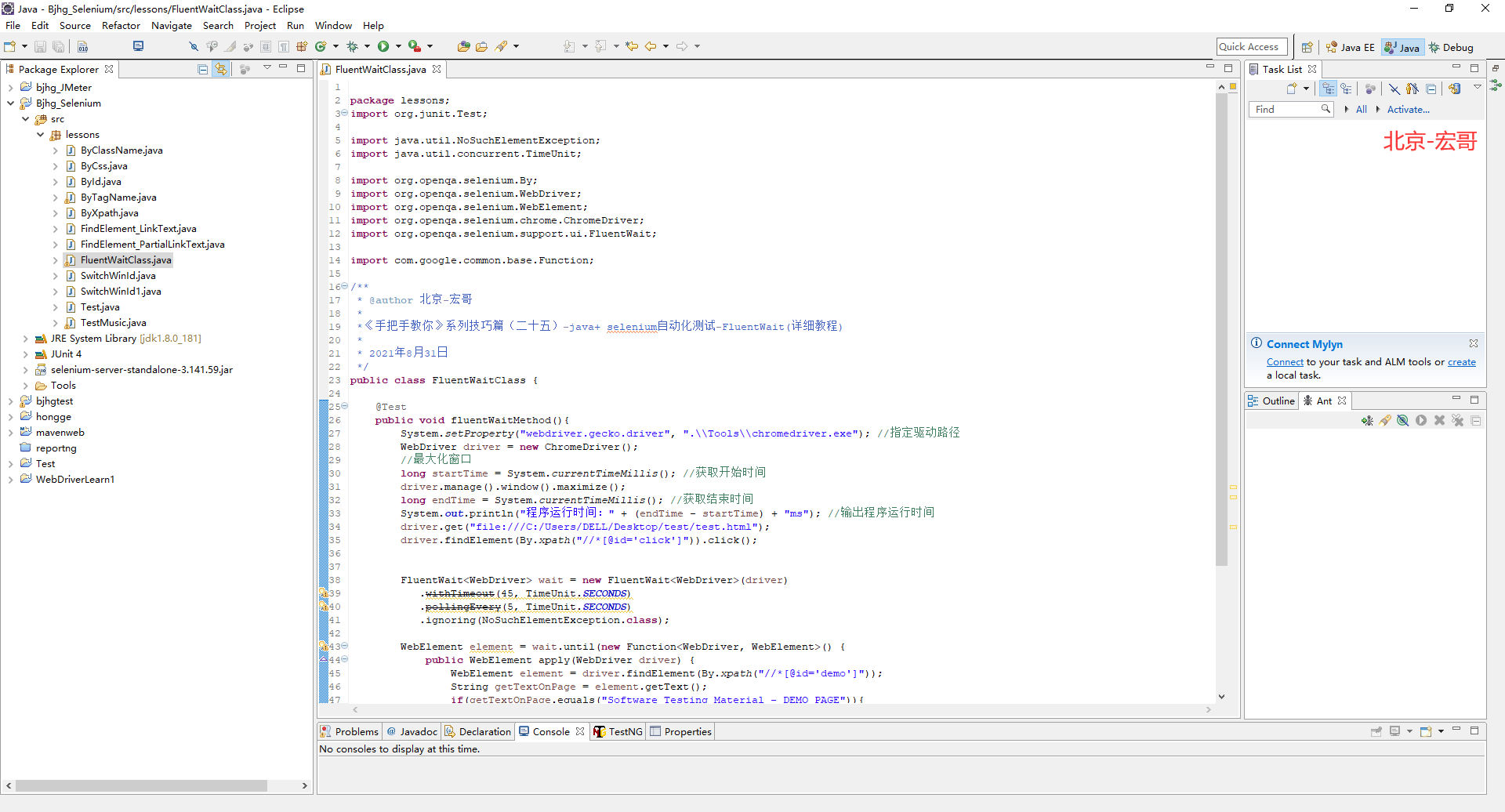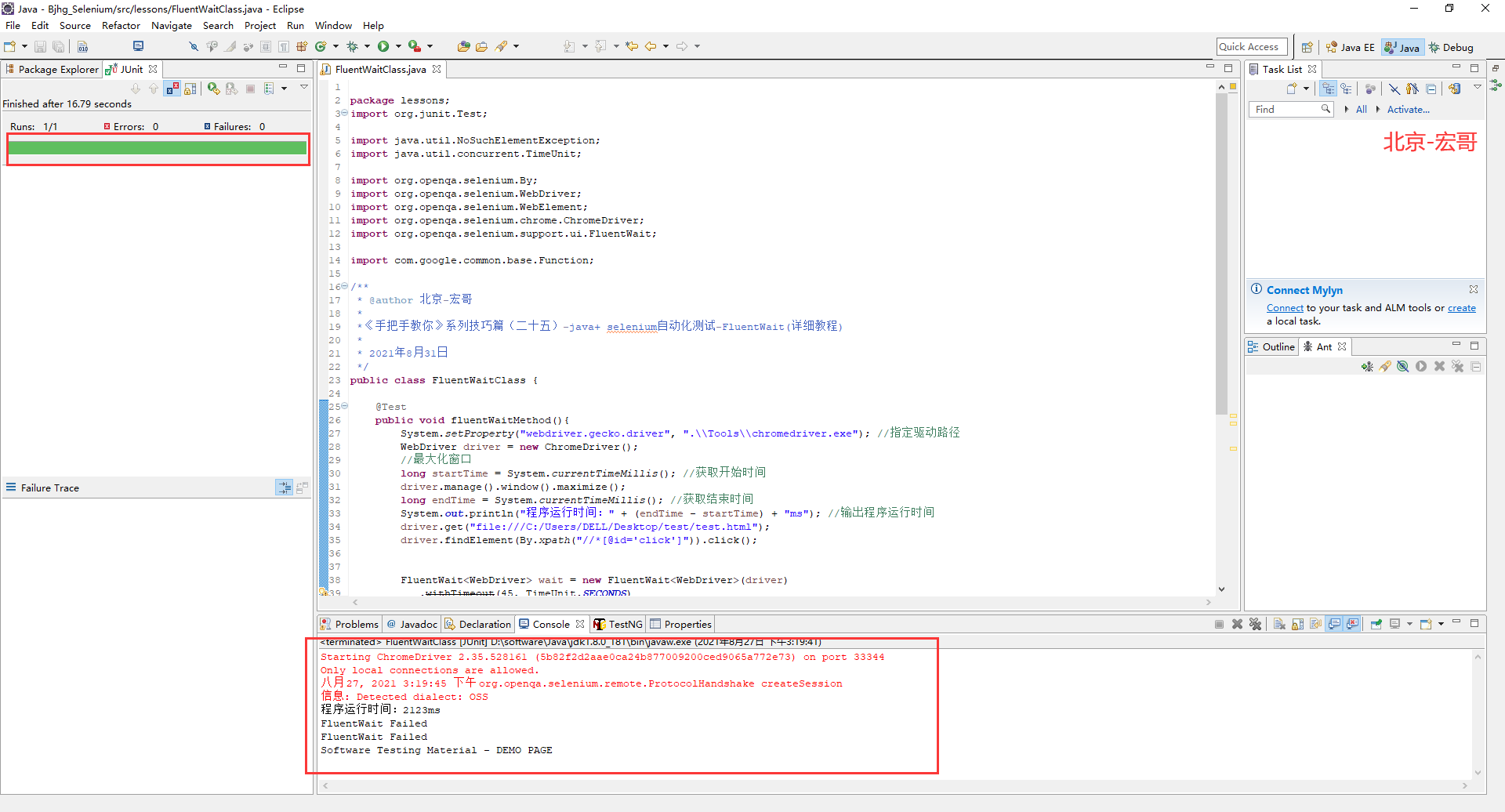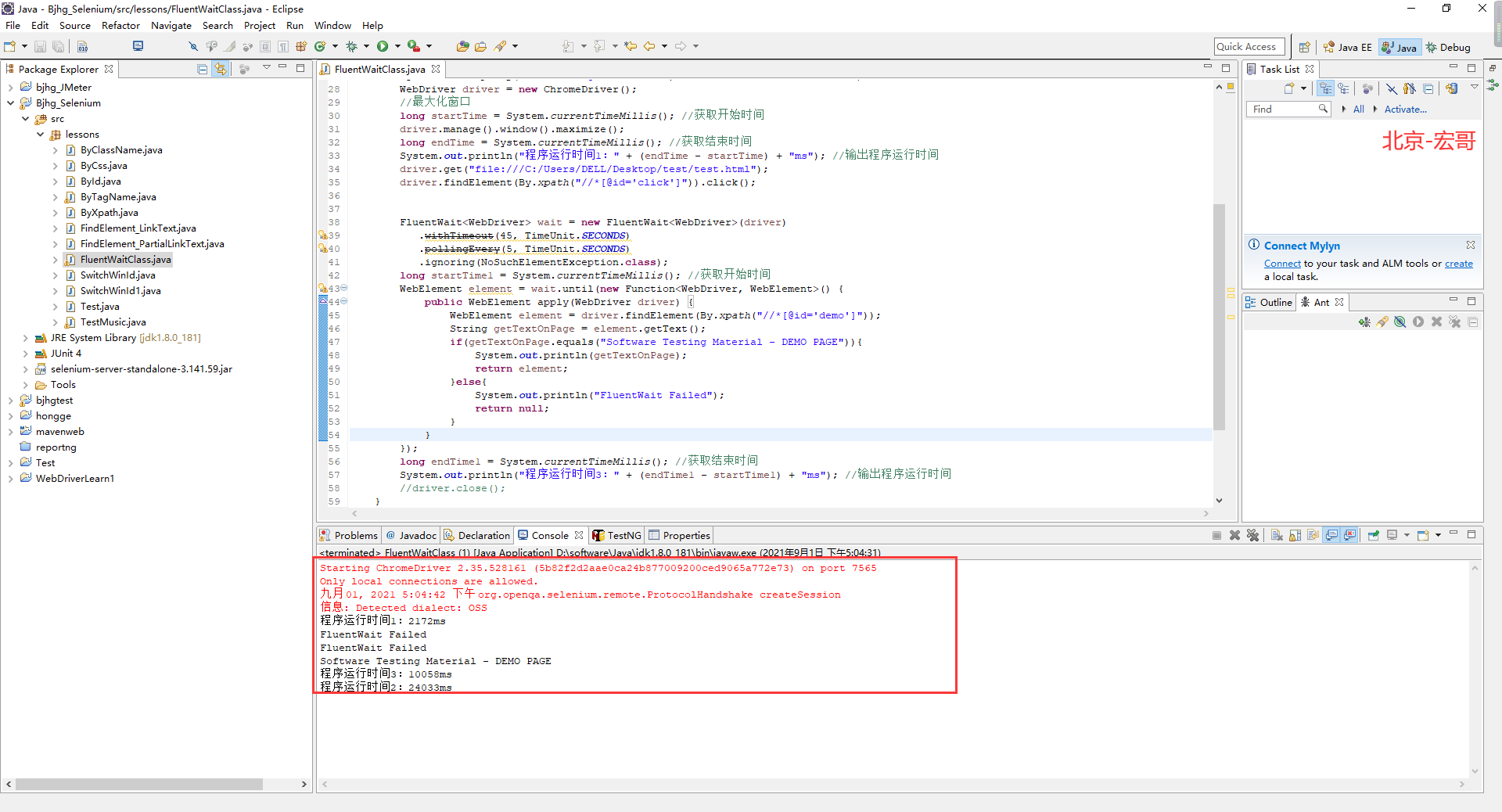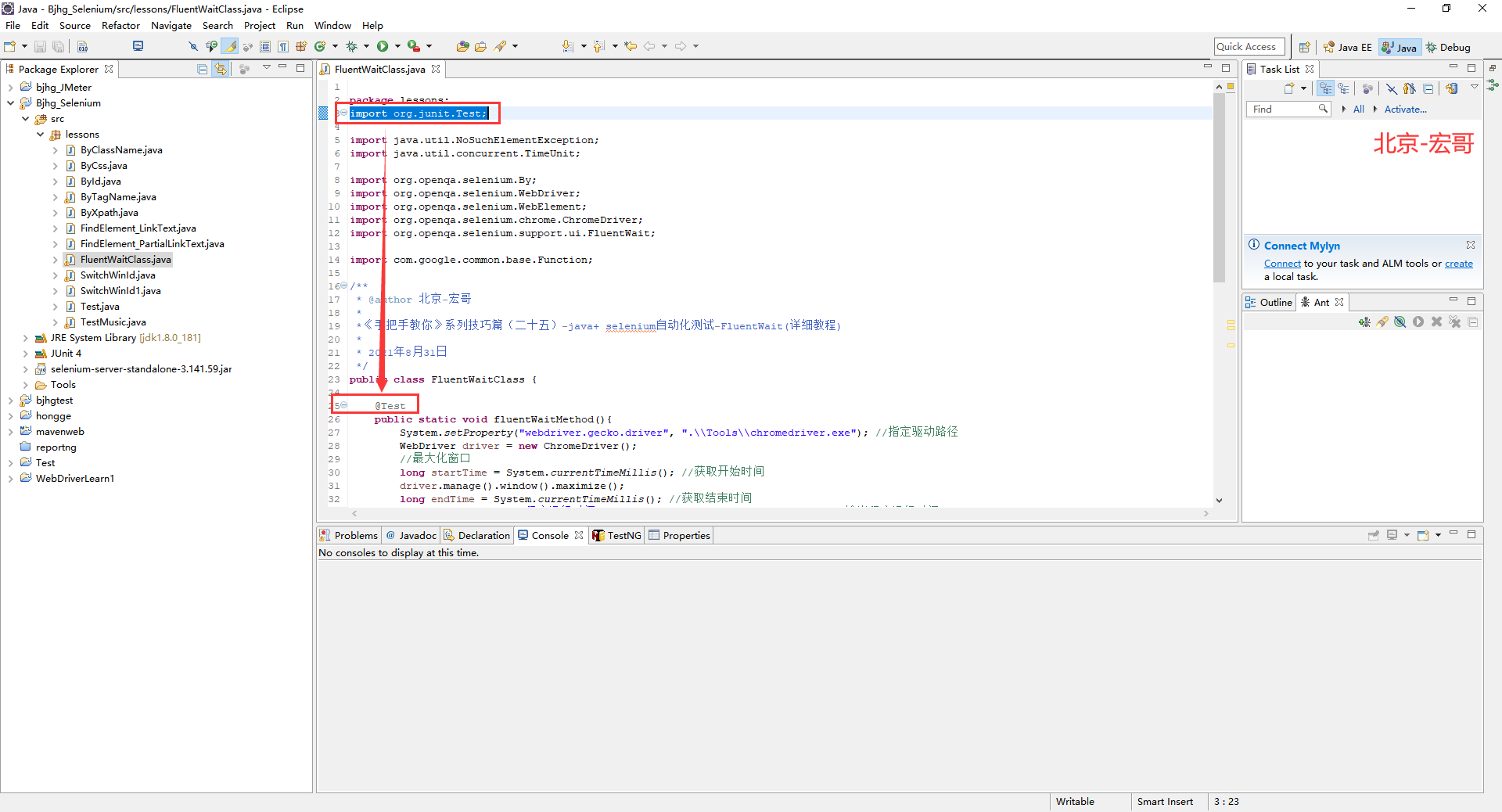《手把手教你》系列技巧篇(二十五)-java+ selenium自动化测试-FluentWait(详细教程)
1.简介
其实今天介绍也讲解的也是一种等待的方法,有些童鞋或者小伙伴们会问宏哥,这也是一种等待方法,为什么不在上一篇文章中竹筒倒豆子一股脑的全部说完,反而又在这里单独写了一篇。那是因为这个比较重要,所以宏哥专门为她量身定制了一篇。
FluentWait是Selenium中功能强大的一种等待方式,翻译成中文是流畅等待的意思。在介绍FluentWait之前,我们来讨论下为什么需要设置等待,我们前面介绍了隐式等待和显式等待。在现在很多软件产品为了加强前端的效果,采取了大量的AJAX 和Jquery技术,很多窗体内的数据,需要等待一会,才能加载完数据,才能出现一些元素,driver才能操作这些元素做一些事情。还有就是我们做一些操作,本身可能也需要等待一会才有数据显示。所以在自动化脚本开发过程,合理的设置时间等待是非常必要的,可以说百分之90以上的自动化测试用例执行失败,基本上是很时间等待有关系,造成元素没有及时在界面上显示,而报no such element子类的错误。
2.FluentWait的定义
简单来说,FluentWait就是一个普通的类,我们使用这个类能支持一直等待直到特定的条件出现。
1)是一个类而且是包org.openqa.selenium.support.ui的一部分
2)是Wait接口的一种实现
3)每个Fluent wait,我们可以设置等待最大时间,而且可以做设置等待的频率去检查一些特定的条件。
FluentWait 和 Explicit Wait的区别:简单来说就是Explicit Wait里有一些设定好了的前置条件的等待方式,而Fluent wait你可以设置自己的方法去处理各种等待的问题。
3.核心代码
3.1源码
宏哥先看一下FluentWait的源码,如何查看宏哥这里就不做赘述了。源码如下:
// Licensed to the Software Freedom Conservancy (SFC) under one
// or more contributor license agreements. See the NOTICE file
// distributed with this work for additional information
// regarding copyright ownership. The SFC licenses this file
// to you under the Apache License, Version 2.0 (the
// "License"); you may not use this file except in compliance
// with the License. You may obtain a copy of the License at
//
// http://www.apache.org/licenses/LICENSE-2.0
//
// Unless required by applicable law or agreed to in writing,
// software distributed under the License is distributed on an
// "AS IS" BASIS, WITHOUT WARRANTIES OR CONDITIONS OF ANY
// KIND, either express or implied. See the License for the
// specific language governing permissions and limitations
// under the License.
package org.openqa.selenium.support.ui;
import com.google.common.base.Throwables;
import com.google.common.collect.ImmutableList;
import org.openqa.selenium.TimeoutException;
import org.openqa.selenium.WebDriverException;
import org.openqa.selenium.internal.Require;
import java.time.Clock;
import java.time.Duration;
import java.time.Instant;
import java.util.ArrayList;
import java.util.Collection;
import java.util.List;
import java.util.function.Function;
import java.util.function.Supplier;
/**
* An implementation of the {@link Wait} interface that may have its timeout and polling interval
* configured on the fly.
*
* <p>
* Each FluentWait instance defines the maximum amount of time to wait for a condition, as well as
* the frequency with which to check the condition. Furthermore, the user may configure the wait to
* ignore specific types of exceptions whilst waiting, such as
* {@link org.openqa.selenium.NoSuchElementException NoSuchElementExceptions} when searching for an
* element on the page.
*
* <p>
* Sample usage: <pre>
* // Waiting 30 seconds for an element to be present on the page, checking
* // for its presence once every 5 seconds.
* Wait<WebDriver> wait = new FluentWait<WebDriver>(driver)
* .withTimeout(30, SECONDS)
* .pollingEvery(5, SECONDS)
* .ignoring(NoSuchElementException.class);
*
* WebElement foo = wait.until(new Function<WebDriver, WebElement>() {
* public WebElement apply(WebDriver driver) {
* return driver.findElement(By.id("foo"));
* }
* });
* </pre>
*
* <p>
* <em>This class makes no thread safety guarantees.</em>
*
* @param <T> The input type for each condition used with this instance.
*/
public class FluentWait<T> implements Wait<T> {
protected static final long DEFAULT_SLEEP_TIMEOUT = 500;
private static final Duration DEFAULT_WAIT_DURATION = Duration.ofMillis(DEFAULT_SLEEP_TIMEOUT);
private final T input;
private final java.time.Clock clock;
private final Sleeper sleeper;
private Duration timeout = DEFAULT_WAIT_DURATION;
private Duration interval = DEFAULT_WAIT_DURATION;
private Supplier<String> messageSupplier = () -> null;
private List<Class<? extends Throwable>> ignoredExceptions = new ArrayList<>();
/**
* @param input The input value to pass to the evaluated conditions.
*/
public FluentWait(T input) {
this(input, Clock.systemDefaultZone(), Sleeper.SYSTEM_SLEEPER);
}
/**
* @param input The input value to pass to the evaluated conditions.
* @param clock The clock to use when measuring the timeout.
* @param sleeper Used to put the thread to sleep between evaluation loops.
*/
public FluentWait(T input, java.time.Clock clock, Sleeper sleeper) {
this.input = Require.nonNull("Input", input);
this.clock = Require.nonNull("Clock", clock);
this.sleeper = Require.nonNull("Sleeper", sleeper);
}
/**
* Sets how long to wait for the evaluated condition to be true. The default timeout is
* {@link #DEFAULT_WAIT_DURATION}.
*
* @param timeout The timeout duration.
* @return A self reference.
*/
public FluentWait<T> withTimeout(Duration timeout) {
this.timeout = timeout;
return this;
}
/**
* Sets the message to be displayed when time expires.
*
* @param message to be appended to default.
* @return A self reference.
*/
public FluentWait<T> withMessage(final String message) {
this.messageSupplier = () -> message;
return this;
}
/**
* Sets the message to be evaluated and displayed when time expires.
*
* @param messageSupplier to be evaluated on failure and appended to default.
* @return A self reference.
*/
public FluentWait<T> withMessage(Supplier<String> messageSupplier) {
this.messageSupplier = messageSupplier;
return this;
}
/**
* Sets how often the condition should be evaluated.
*
* <p>
* In reality, the interval may be greater as the cost of actually evaluating a condition function
* is not factored in. The default polling interval is {@link #DEFAULT_WAIT_DURATION}.
*
* @param interval The timeout duration.
* @return A self reference.
*/
public FluentWait<T> pollingEvery(Duration interval) {
this.interval = interval;
return this;
}
/**
* Configures this instance to ignore specific types of exceptions while waiting for a condition.
* Any exceptions not whitelisted will be allowed to propagate, terminating the wait.
*
* @param types The types of exceptions to ignore.
* @param <K> an Exception that extends Throwable
* @return A self reference.
*/
public <K extends Throwable> FluentWait<T> ignoreAll(Collection<Class<? extends K>> types) {
ignoredExceptions.addAll(types);
return this;
}
/**
* @param exceptionType exception to ignore
* @return a self reference
* @see #ignoreAll(Collection)
*/
public FluentWait<T> ignoring(Class<? extends Throwable> exceptionType) {
return this.ignoreAll(ImmutableList.<Class<? extends Throwable>>of(exceptionType));
}
/**
* @param firstType exception to ignore
* @param secondType another exception to ignore
* @return a self reference
* @see #ignoreAll(Collection)
*/
public FluentWait<T> ignoring(Class<? extends Throwable> firstType,
Class<? extends Throwable> secondType) {
return this.ignoreAll(ImmutableList.of(firstType, secondType));
}
/**
* Repeatedly applies this instance's input value to the given function until one of the following
* occurs:
* <ol>
* <li>the function returns neither null nor false</li>
* <li>the function throws an unignored exception</li>
* <li>the timeout expires</li>
* <li>the current thread is interrupted</li>
* </ol>
*
* @param isTrue the parameter to pass to the {@link ExpectedCondition}
* @param <V> The function's expected return type.
* @return The function's return value if the function returned something different
* from null or false before the timeout expired.
* @throws TimeoutException If the timeout expires.
*/
@Override
public <V> V until(Function<? super T, V> isTrue) {
Instant end = clock.instant().plus(timeout);
Throwable lastException;
while (true) {
try {
V value = isTrue.apply(input);
if (value != null && (Boolean.class != value.getClass() || Boolean.TRUE.equals(value))) {
return value;
}
// Clear the last exception; if another retry or timeout exception would
// be caused by a false or null value, the last exception is not the
// cause of the timeout.
lastException = null;
} catch (Throwable e) {
lastException = propagateIfNotIgnored(e);
}
// Check the timeout after evaluating the function to ensure conditions
// with a zero timeout can succeed.
if (end.isBefore(clock.instant())) {
String message = messageSupplier != null ?
messageSupplier.get() : null;
String timeoutMessage = String.format(
"Expected condition failed: %s (tried for %d second(s) with %d milliseconds interval)",
message == null ? "waiting for " + isTrue : message,
timeout.getSeconds(), interval.toMillis());
throw timeoutException(timeoutMessage, lastException);
}
try {
sleeper.sleep(interval);
} catch (InterruptedException e) {
Thread.currentThread().interrupt();
throw new WebDriverException(e);
}
}
}
private Throwable propagateIfNotIgnored(Throwable e) {
for (Class<? extends Throwable> ignoredException : ignoredExceptions) {
if (ignoredException.isInstance(e)) {
return e;
}
}
Throwables.throwIfUnchecked(e);
throw new RuntimeException(e);
}
/**
* Throws a timeout exception. This method may be overridden to throw an exception that is
* idiomatic for a particular test infrastructure, such as an AssertionError in JUnit4.
*
* @param message The timeout message.
* @param lastException The last exception to be thrown and subsequently suppressed while waiting
* on a function.
* @return Nothing will ever be returned; this return type is only specified as a convenience.
*/
protected RuntimeException timeoutException(String message, Throwable lastException) {
throw new TimeoutException(message, lastException);
}
}
3.2语法
宏哥从源码中的Sample usage提取FluentWait的使用语法如下:
Wait wait = new FluentWait(WebDriver reference)
.withTimeout(timeout, SECONDS)
.pollingEvery(timeout, SECONDS)
.ignoring(Exception.class);
WebElement foo=wait.until(new Function<WebDriver, WebElement>() {
public WebElement applyy(WebDriver driver) {
return driver.findElement(By.id("foo"));
}
});
3.3例子
有了语法,按照语法写一个简单例子,如下:
Wait wait = new FluentWait<WebDriver>(driver)
.withTimeout(45, TimeUnit.SECONDS)
.pollingevery(5, TimeUnit.SECONDS)
.ignoring(NoSuchElementException.class);
FluentWait主要使用两个参数–超时值(withTimeout)和轮询频率(pollingevery)。在上面的语法中,我们将超时值设置为45秒,轮询频率设置为5秒。等待条件的最长时间(45秒)和检查指定条件成功或失败的频率(5秒)。如果元素在此时间范围内可以查找到,它将执行下一步操作,否则它将抛出“ElementNotVisibleException”。
3.4完整代码
简单例子的完整代码如下:
package lessons;
import java.util.concurrent.TimeUnit;
import org.openqa.selenium.By;
import org.openqa.selenium.NoSuchElementException;
import org.openqa.selenium.WebDriver;
import org.openqa.selenium.WebElement;
import org.openqa.selenium.chrome.ChromeDriver;
import org.openqa.selenium.support.ui.FluentWait;
import org.openqa.selenium.support.ui.Wait;
import com.google.common.base.Function;
public class FluentWait {
public static void main(String[] args) throws Exception {
System.setProperty("webdriver.chrome.driver", ".\\Tools\\chromedriver.exe");
WebDriver driver = new ChromeDriver();
driver.get("www.test.com");
driver.manage().window().maximize();
Wait<WebDriver> wait = new FluentWait<WebDriver>(driver)
.withTimeout(45, TimeUnit.SECONDS)
.pollingEvery(5, TimeUnit.SECONDS)
.ignoring(NoSuchElementException.class);
WebElement ele1 = wait.until(new Function<WebDriver, WebElement>() {
public WebElement apply(WebDriver driver) {
return driver.findElement(By.id("xxxxxxx"));
}
});
}
}
4.项目实战
由于没有现成的网页或者网站以供宏哥进行演示,因此宏哥自己简单写了一个demo以便演示使用。
4.1测试网页代码
宏哥这个网页主要思想就是点击按钮后10s倒计时,倒计时结束出现元素(一段英文文字)。
测试网页test.html,参考代码如下所示:
<html> <head> <meta http-equiv="Content-Type" content="text/html; charset=utf-8" /> <title>北京-宏哥</title> </head> <style> #click { background-color: #4CAF50; border: none; color: white; padding: 15px 32px; text-align: center; text-decoration: none; display: inline-block; font-size: 16px; margin: 4px 2px; cursor: pointer; } .button { background-color: #f44336; border: none; color: white; padding: 15px 32px; text-align: center; text-decoration: none; display: inline-block; font-size: 28px; margin-bottom: 100px; } #myAnchor { text-decoration:none; color: white; } </style> <body> <div style=" text-align:center;"> <div style="height: 100px;margin-top: 200px;"> <button class="button"><a id="myAnchor" href="https://www.cnblogs.com/du-hong/">北京-宏哥</a></button></br> <input type="button" value="Click Me - Fluent Wait" id="click" onclick="foo(this, 10000);"/> <p style='color:red; font-family: verdana; font-size: 20;align="center";' id="demo">Click and Wait for <b>10 seconds</b> to view a message - "Software Testing Material - DEMO PAGE"</p> </div> </div> </body> <script> function foo(obj, time) { obj.disabled = true; setTimeout(function() { var x = setInterval(function(){ time= time - 1000; //reduce each second obj.value = (time/1000)%60; if(time==0){ clearInterval(x); obj.value = document.getElementById("demo").innerHTML = "Software Testing Material - DEMO PAGE"; obj.disabled = false; } }, 1000); }, time-10000); } </script> </html>
下边宏哥编写java测试脚本。
4.2代码设计
设计思路:打开网页后,点击按钮开始5s频率的轮训查找元素,第一次没有找到,第二次10s刚好出现,代码也轮训查找也刚结束,没有找到,等到第三次英文文字出现了,代码也查找到,结束轮训,继续下一步操作。代码设计如下图所示:

4.3Java参考代码
宏哥首页用单元测试Junit测试一下写的方法有没有问题,没有问题,然后再调用。
4.3.1运行代码
1.运行代码,右键Run AS->JUnit Test,控制台输出,绿色的进度条证明写的方法没有问题,而且控制台也循环了2次(每次5s,一共10s),等待到了元素的出现并将其打印出来。如下图所示:

2.运行代码后电脑端的浏览器的动作,如下小视频所示:
4.4Java优化参考代码
通过上边的单元测试我们知道写的方法没有问题,那么下边我们直接调用该方法即可。优化后代码如下:
package lessons; import org.junit.Test; import java.util.NoSuchElementException; import java.util.concurrent.TimeUnit; import org.openqa.selenium.By; import org.openqa.selenium.WebDriver; import org.openqa.selenium.WebElement; import org.openqa.selenium.chrome.ChromeDriver; import org.openqa.selenium.support.ui.FluentWait; import com.google.common.base.Function; /** * @author 北京-宏哥 * *《手把手教你》系列技巧篇(二十五)-java+ selenium自动化测试-FluentWait(详细教程) * * 2021年8月31日 */ public class FluentWaitClass { @Test public static void fluentWaitMethod(){ System.setProperty("webdriver.gecko.driver", ".\\Tools\\chromedriver.exe"); //指定驱动路径 WebDriver driver = new ChromeDriver(); //最大化窗口 long startTime = System.currentTimeMillis(); //获取开始时间 driver.manage().window().maximize(); long endTime = System.currentTimeMillis(); //获取结束时间 System.out.println("程序运行时间1:" + (endTime - startTime) + "ms"); //输出程序运行时间 driver.get("file:///C:/Users/DELL/Desktop/test/test.html"); driver.findElement(By.xpath("//*[@id='click']")).click(); FluentWait<WebDriver> wait = new FluentWait<WebDriver>(driver) .withTimeout(45, TimeUnit.SECONDS) .pollingEvery(5, TimeUnit.SECONDS) .ignoring(NoSuchElementException.class); long startTime1 = System.currentTimeMillis(); //获取开始时间 WebElement element = wait.until(new Function<WebDriver, WebElement>() { public WebElement apply(WebDriver driver) { WebElement element = driver.findElement(By.xpath("//*[@id='demo']")); String getTextOnPage = element.getText(); if(getTextOnPage.equals("Software Testing Material - DEMO PAGE")){ System.out.println(getTextOnPage); return element; }else{ System.out.println("FluentWait Failed"); return null; } } }); long endTime1 = System.currentTimeMillis(); //获取结束时间 System.out.println("程序运行时间3:" + (endTime1 - startTime1) + "ms"); //输出程序运行时间 //driver.close(); } public static void main(String [] args){ long startTime = System.currentTimeMillis(); //获取开始时间 fluentWaitMethod(); long endTime = System.currentTimeMillis(); //获取结束时间 System.out.println("程序运行时间2:" + (endTime - startTime) + "ms"); //输出程序运行时间 } }
4.4.1运行代码
1.运行代码,右键Run AS->java Application,控制台输出,如下图所示:

2.运行代码后电脑端的浏览器的动作,如下小视频所示:
5.小结
1.在设计代码过程中会报错:Type mismatch: cannot convert from Test to Annotation 如下图所示:

查了好多都说是:类名不能和注解名称相同的原因。后来宏哥检查了一下,不相同啊,但是宏哥为啥这里还会报这个错了。原来是宏哥没有导入单元测试的包,但是也没有提示导入包,因此宏哥将包导入,代码错误消失。如下图所示:

好了,今天就分享到这里了,感谢你耐心的阅读!
感谢您花时间阅读此篇文章,如果您觉得这篇文章你学到了东西也是为了犒劳下博主的码字不易不妨打赏一下吧,让博主能喝上一杯咖啡,在此谢过了!
如果您觉得阅读本文对您有帮助,请点一下左下角“推荐”按钮,您的
本文版权归作者和博客园共有,来源网址:https://www.cnblogs.com/du-hong 欢迎各位转载,但是未经作者本人同意,转载文章之后必须在文章页面明显位置给出作者和原文连接,否则保留追究法律责任的权利!
公众号(关注宏哥) 客服微信





